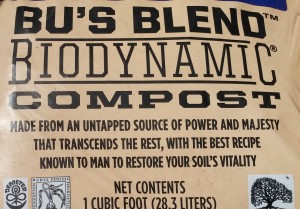Last week I was having lunch with my mom at our favorite nearby nursery/café. After failing to resist the grilled cheese sandwich (3 cheeses! And buttery panini bread!), we walked off lunch in the garden supply part of the nursery. Normally I’m on my best behavior when I’m shopping with my mom (i.e. I don’t take photos of things I’m going to take to task on the blog). But like the 3-cheese grilled sandwich I was unable to resist the bags of biodynamic compost.

Long-time readers of the blog may remember my earlier column and post on biodynamics. Since I wrote the original column over 10 years ago I’ve watched biodynamic marketing move from boutique wines to coffee, tea, tomato sauce…and now to garden products. Really expensive garden products, as in $19.99 for one cubic foot of compost.

What makes this bag of compost worth $19.99? One has to assume it’s the biodynamic preparations used to treat the compost. They’re referred to in the label under “concentrations of yarrow” and so on. Do these preparations make a difference? The label suggests it might be to restore the soil’s vitality. Is there validity to this claim?

In 2013 I published a review of the scientific literature on biodynamics, specifically looking at whether biodynamic preparations have a measurable impact on anything they’re applied to. In a nutshell, the answer is no. (Though this article is behind a paywall, I can send a pdf to you by email if you’d like to read it.)
Don’t let packaging and magical words sway you. Compost made with local materials like bark or agricultural wastes and certified by the US Composting Council is reasonably priced and sustainable.
